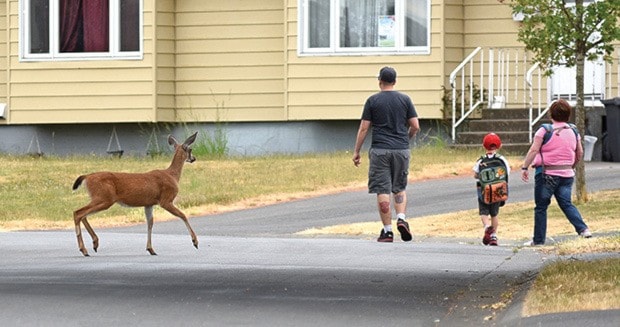Oak Bay is not immune to the rare yet increasing scenario of aggressive deer.
The district put out an educational release reminding residents of deer safety after receiving reports of protective does in the community.
“We had four encounters last week,” said Helen Koning, CAO. “It’s just reminding people that it’s fawning season, does are very protective of their fawns and [people should] give a wide berth. When it comes to deer, it’s the responsibility of the province, so we’re just trying to continue the education and remind people, particularly at this time of year.”
Since April 1 the 24/7 wildlife hotline (1-877-952-7277) received 11 deer calls, two of them regarding aggressive deer, says Mike Badry, provincial wildlife conflict specialist.
“This time of year it’s does with fawns in response to dogs. That really seems to be the primary trigger,” Badry said. “It can be difficult to predict when a deer is going to be aggressive until they make a move.”
“In general we say be aware of your surroundings,” he said. “Give deer a wide berth if you see them. If you know there are aggressive deer in an area – and they tend to be individual deer, particularly doe protecting fawns at this time of year – change your walking route, especially if you’re walking a dog.”
He also advises people to carry a walking stick, not to hit an animal necessarily, but to maintain a space if one does approach.
“It’s kind of a new phenomenon of this happening in urban areas. It’s a habituation,” Badry said.
The belief is deer have lost the fear response to dogs, who appear similar to natural predators, such as wolves.
“Over the last 10 years it’s been a phenomenon in North America,” Badry said. “We certainly encourage people to report it if they have an encounter.”
Reports to the call centre are passed on to local conservation services where they assess all calls and make a decision on response. That could mean attempting to find an animal.
“The decision really revolves around public safety,” Badry said. “We’ll also use that call to focus our education efforts around how you can try to reduce conflict in your community.”
Focus on what’s attracting deer, he suggests, fence off plants they find attractive or simply don’t plant them. With the rise in urban deer populations local greenhouses and garden shops feature lists of plants that don’t attract deer.
“Try to deter deer from utilizing your property,” he said, noting information is widely available, including the conservation website http://www.env.gov.bc.ca/cos/.
“One of the great things about this being a big issue is there’s lots of information out there,” he said.
Motion-activated sprinklers are an idea, anything really that makes it less enjoyable for a deer to be in the yard
“Certainly don’t feed deer,” Badry said.
Feeding deer in Oak Bay can come with a fine as high as $500 for repeat offenders.
The other nine calls to Conservation since April 1 concerned dead, injured or orphaned deer, which prompts another spring warning.
Don’t pick up orphaned, or what appear to be orphaned, fawns. They’re rarely actually orphaned.
“[Does] leave their fawns all the time to go off and forage,” Badry said.
Residents can report wildlife interactions where public safety is at risk to the provincial Conservation Officer Service by calling 1-877-952-7277 toll free. Find more information on the Ministry of Environment website at env.gov.bc.ca.
cvanreeuwyk@oakbaynews.com
